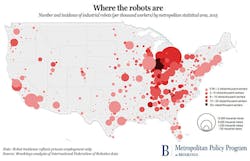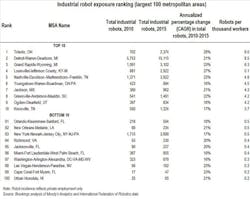Industrial robots may deal with a lot of ones and zeroes, but their programming may soon include Midwestern values as well, based on new mapping data from the Brookings Institute. The report, "Where the robots are," shows that 29% of the 233, 305 industrial robots in America are being put to work in three states: Indiana (8.3%), Ohio (8.7%) and Michigan (12%).
Here's a map Brookings' Metropolitan Policy Program put together that shows industrial robot density (per 1,000 workers), and in case of Skynet, the places to avoid.
A decade ago, this map might have indicated where humans were running from, as offshoring and the economic crash made the Rust Belt nearly uninhabitable. Now it's like West World, with robots everywhere you look. Toledo has the highest distribution, with nine per 1,000 workers. Toledo's total number of industrial robots jumped from 702 to 2,374 robots from 2010 to 2015, for a yearly increase of 28%.
As we are based near the epicenter of this robot invasion, in Cleveland, Ohio, let me say for the record, I, for one, welcome our new robot overlords.
The table below shows the top and bottom rankings:
A the bottom, you can see places like Las Vegas and Honolulu don't have many industrial workers, though the tourist destinations may someday lead the pack in entertainment robots.
Detroit, which declared bankruptcy in 2013, has the highest concentration of industrial robots for a major metro area, with 8.5 per 1,000. There are more than 15,000 industrial robots in the Motor City. That's nine times the amount of cops patrolling the streets. It's wholly plausible that Robocop will happen in our lifetimes, or at least before the Detroit Lions win a Super Bowl.
The major driver is, of course, the automotive industry, which buy about 40% of all industrial robots worldwide, according to the International Federation of Robotics. Sales have increased 20% annually.
This number doesn't look to be slowing down, as General Motors announced shortly after the 2016 Presidential election that they are investing $667 million in the GM Toledo Transmission plant, which employs only 739 jobs. This probably means robots will be a big part of putting together the 6 and 8-speed transmissions.
For anyone worried about illegal immigrants taking their jobs, they should consider that robots hourly "pay" can be a third less, even when factoring in installation and maintenance. The Boston Consulting Group says that a human welder makes $25/hr in a U.S. factory, while a robot costs only $8. By 2030, robots could cost as little as $2.
Before you start smashing Roomba in protest, please know that this is only part of the story. The in-depth report, "The zombie robot argument lurches on," allays some fears, providing a counterpoint to "Robots and Jobs: Evidence from US Labor Markets" by MIT economists Daron Acemoglu and Pascual Restrepo:
While A&R's report shows that "robots" are negatively correlated with employment growth across commuting zones, it finds that all other indicators of automation (nonrobot IT investment) are positively correlated or neutral with regard to employment. So even if robots displace some jobs in a given commuting zone, other automation (which presumably dwarfs robot automation in the scale of investment) creates many more jobs.
The paper also argues that trade is more detrimental to job growth than automation:
A&R themselves find that U.S. trade with China displaced three times as many jobs as did robots. We show that in the 2000s, Chinese trade displaced four times as many jobs as robots.
One final thing to note: Brookings found there are twice as many robots in red states, or those that voted for Donald Trump, than the blue states that voted for Hillary Clinton:
It's unclear if the Rust Belt will this time be decimated by the robots in their own plants and factories as opposed to the ones in Japan, as happened in the 1970s and '80s. If the region embraces robotics, it could find a way to leverage automation to create brand new industries, as it did when the automotive industry exploded a century ago. If it doesn't, you can always move to Alaska or Hawaii.


















